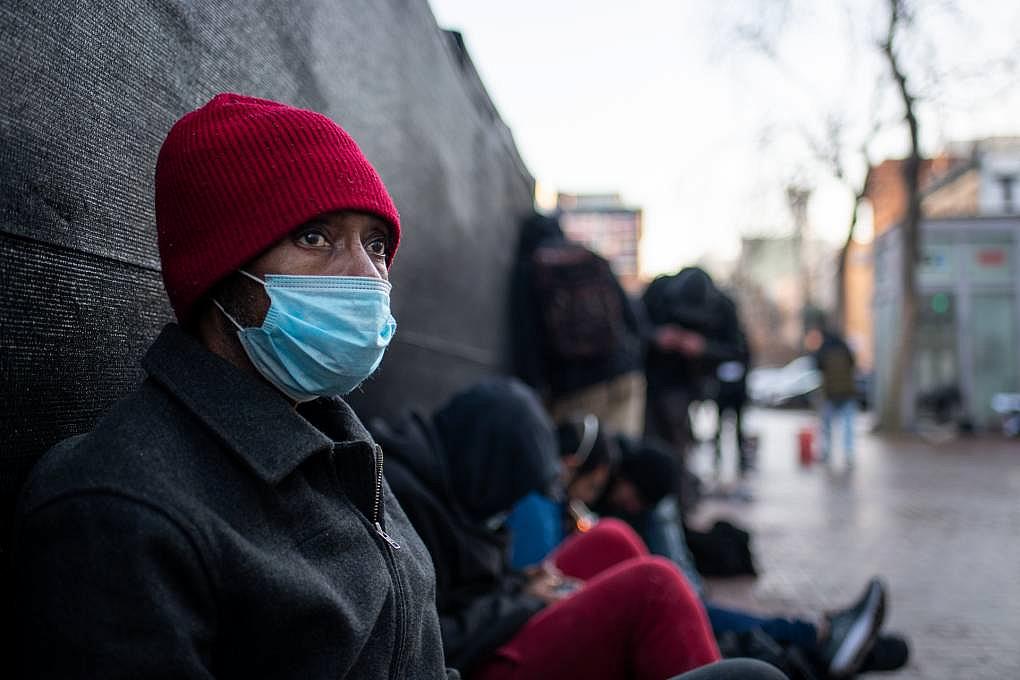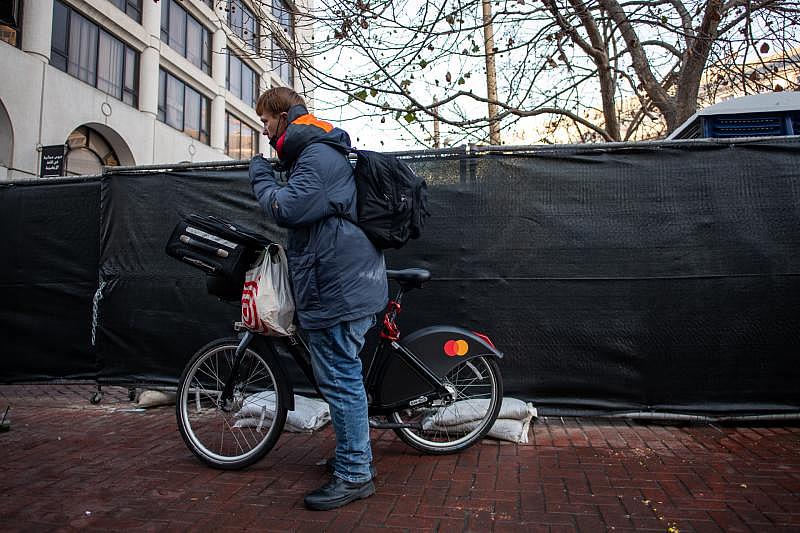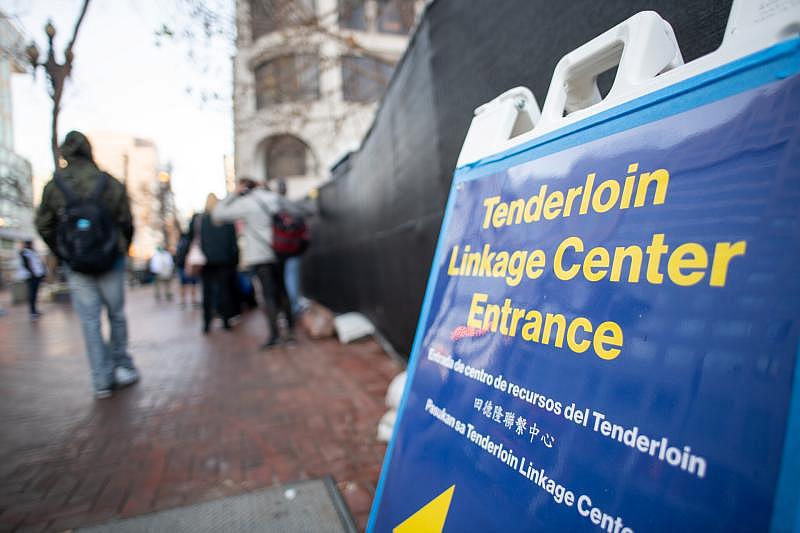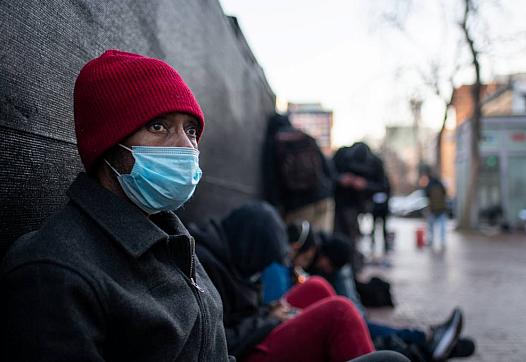New Tenderloin Site Highlights Challenge of Connecting People to Drug Treatment and Housing Services
The story was originally published in KQED with support from the USC Annenberg Center for Health Journalism’s 2021 Data Fellowship.

Keith Thompson waits to get in to the Tenderloin Linkage Center in San Francisco on Feb. 8, 2022.
(Beth LaBerge/KQED)
Most mornings, around 8 a.m., dozens of people line up in San Francisco’s Civic Center Plaza outside the city’s new one-stop social service site — called the Tenderloin Linkage Center — where food and showers are offered, along with referrals for housing, jobs, drug treatment and a range of other services.
On one recent morning, Christopher, who is unhoused and lives on the streets, was among those waiting outside the site, clinging to his bicycle. He said he comes here to use fentanyl in a safe environment where people don’t harass him.
KQED is using only Christopher’s first name because of safety concerns he has.
A long-time fentanyl user, Christopher comes here as often as he can, and is hoping this morning to finally get an appointment for a housing placement.
“I've been waiting a long time, a very long time,” he said. “I have faith that they will make it happen. It's just that I need to make it happen.”
Christopher said he previously had a housing appointment set up by staff at the site, but overslept because he normally stays awake all night, and is ready to try again.
“This is not a life for me,” he said. “This [drug] has torn me down mentally and physically and in ways I can’t describe.”
San Francisco launched the linkage center in January as part of Mayor London Breed’s state of emergency declaration for the beleaguered Tenderloin neighborhood — “an effort to more quickly and directly connect people to services,” she said in a statement at the time. “We've made a commitment to this neighborhood and its residents and businesses, and we will follow through.”
The new site opened amid mounting pressure on city leaders to reduce open-air drug use and skyrocketing overdose deaths in the neighborhood.
But how well the site is working is still unclear. The latest data from the city shows that only a tiny percentage of visits have thus far actually resulted in drug treatment.

Christopher waits in line to get in to the Tenderloin Linkage Center in San Francisco on Feb. 8, 2022. (Beth LaBerge/KQED)
Between Jan. 31 and March 27, the center had more than 20,100 visits from people seeking everything from drug treatment and housing placement to job and mental health counseling. Fewer than 15 of those visits resulted in “completed linkages” for drug treatment services, in which placements were confirmed.
Meanwhile, the number of referrals for drug treatment — in which a person is told where they can access services and shows a willingness to do so — was higher, at nearly 110, but still made up a very small percentage of total visits.
Note that while many of those who visit the center experience substance use disorder, the exact percentage of visitors in this category is unclear.
KQED tabulated these figures using data from weekly operations reports published by the city's Public Health Department, and its dashboard on overdose deaths and reversals. Drug treatment placements include those for outpatient, detox and residential services, as well as medication-assisted treatment.
Despite the low rate of completed linkages for treatment or referrals, some harm reduction advocates and city officials say the center holds promise because people who would otherwise be hard to reach are now showing up.
The San Francisco Department of Public Health said measuring success is more complicated than just reviewing the number of linkages.
“Achieving a basic level of safety and security is a necessary first step toward potentially being open to treatment, and making progress takes time,” the department said in an email. “By providing a safe space, we build relationships and work with guests to find ways to improve their health, including treatment for substance-use disorders, mental health, and other medical care.”
Vitka Eisen, CEO of HealthRIGHT 360, a nonprofit health provider that offers harm-reduction services at the linkage center, said it’s unrealistic to assume people who use drugs will suddenly walk in seeking treatment.
“It really takes a fair amount of time for people to build a relationship, and take positive steps towards their health,” she said. “That takes a minute. It doesn’t happen because all of a sudden there’s a nice person here who says, ‘Hey, I can get you into treatment today if you want that.’ That’s not how that works.”
And even if it did, Eisen said, people would still likely have to wait for those services because the county and the state are in the midst of a staffing crisis.
“We’re one of the largest providers of substance-use treatment in San Francisco, and we do not have enough staff to be able to complete the assessment to put people into treatment rapidly,” she said. “And once they get into treatment, we don’t have enough staff to prepare the treatment plan. A bed is just a bed if you can’t staff it.”
City officials also emphasize that one of the site’s goals is to prevent overdose deaths, and say staff there already have overseen more than 50 overdose reversals using the medication naloxone.
Dr. Daniel Ciccarone, an addiction and drug researcher at UCSF, said those reversal numbers are good news.
“The one shining star, check mark that I see is there’s no deaths on site, despite the fact that they’re engaging with active fentanyl users,” said Ciccarone, referring to data posted through the end of February.
Despite that achievement, he said, too few people who visit the linkage center have been connected to permanent, supportive housing. He worries that the root causes of addiction, like poverty and homelessness, are still not being adequately addressed.
Evidence shows that housing — particularly housing that includes case management and other wraparound services — often leads to positive health outcomes for people who use drugs, Ciccarone noted.
“We have done things like this before. We’ve put fences around the park, we’ve tried to cajole people into treatment, and the ER has their case management for frequent fliers [repeat visitors to the ER] and all that stuff, but yet generation by generation the problem gets worse,” he said. “We live in a wealthy city with a huge income disparity, and we simply don’t have enough resources for our poorest and most marginalized citizens.”
Last year, 645 people in the city died from drug overdoses, nearly a quarter of whom were unhoused or did not have a fixed address, according to the medical examiner’s office.
And in just the first two months of this year, 98 people in San Francisco already have died from drug overdoses — nearly a quarter of them in the Tenderloin.

People wait in line to get in to the Tenderloin Linkage Center in San Francisco on Feb. 8, 2022. (Beth LaBerge/KQED)
Yet, as of February, even as some 1,600 unhoused people in the city had been approved for supportive housing and were awaiting their turn to move in, nearly 900 units sat vacant, due largely to bureaucratic delays, according to a recent San Francisco Public Press/ProPublica investigation. Filling those empty rooms would cut the waiting list by more than half, and house roughly one in every eight unhoused people in the city.
Jacqui Berlinn, co-founder of the group Mothers Against Drug Deaths, said her son Corey, who is addicted to fentanyl, recently came to the linkage center looking for housing.
“He was told the first time there was nothing available and he had to come back, and he went back a second time and he was told the same thing,” she said. “It’s incredibly frustrating. It makes me really angry because I feel like that would be a start to him getting well.”
Berlinn and several other mothers held a demonstration outside the center in February, protesting its policy of allowing people to use illicit drugs in a fenced-off outdoor area attached to the building — an approach, they argue, that deters treatment.
DPH said in a statement that officials are working to eliminate barriers to care by having on-site staff trained to facilitate connections, and are working with behavioral-health providers to quickly accept referrals. The agency also defended the sanctioned drug use at the facility, noting that “the site design, staffing, and setup allow guests to be observed for safety at all times while respecting guest privacy.”
There also are plans, it said, to open a drug-free “sober living room” at the linkage center for those who want it.
Berlinn, though, said she has given up on waiting for the linkage center to help her son with housing or connections to long-term services. She said there are still too many systematic barriers when people seek assistance.
“They need treatment on demand,” said Berlinn, who is now researching treatment options outside of San Francisco. “It’s this whole ‘come back tomorrow’ that people are faced with, that makes them feel hopeless. It needs to be, ‘Let’s go, let’s do this, here’s your support, here’s what we’re going to do.”
This article was produced as a project for the USC Annenberg Center for Health Journalism's 2021 Data Fellowship. KQED's Kate Wolffe contributed reporting for this story.
[This story was originally published by KQED.]
Did you like this story? Your support means a lot! Your tax-deductible donation will advance our mission of supporting journalism as a catalyst for change.

